That Useful Wine Site
Search, or just roll your cursor over the colored boxes farther below.click the “x” to dismiss Search-results block.
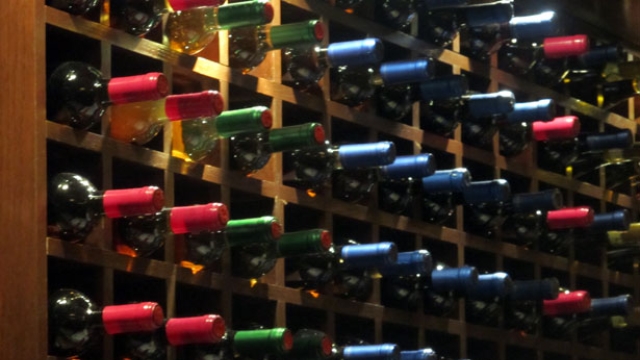
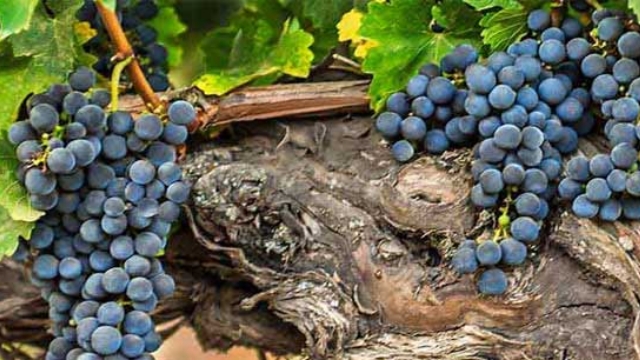
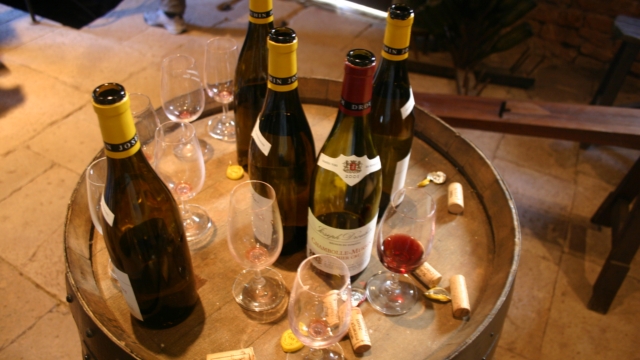
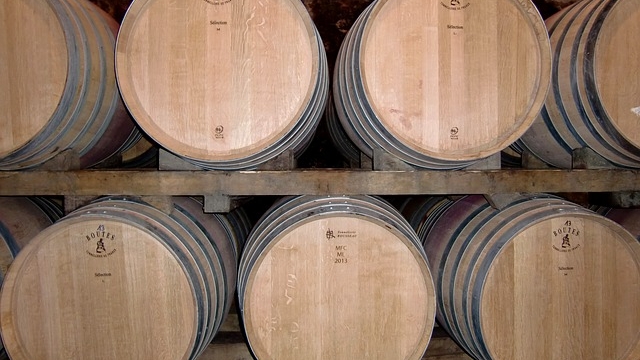
Advertisement:
Advertisement:
Quick page jumps:
(Synonyms: Abundante, Alicante, Aragones, Bernacha Negra, Bois Jaune, Cannonao, Cannonau, Catalunya, Cranaxia, Garnaxa, Gironet, Granache, Granaxa, Granaxia,Grenache, Grenache Crni, Grenache Noir, Licante, LLadoner, Redondal, Ranaccio, Roussillon, Sans Pareil, Tai Rosso, Tinto Basso, Tocai Rosso, Vernaccia Nero, Vrannaxia)
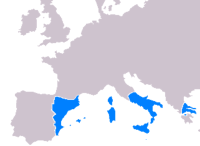
Garnacha Tinta (usually just called Garnacha) is a red-wine grape originating in the Aragon region of northern Spain; from there, it was early on spread through the regions then under the Aragonese crown, including southern France, whence it spread widely. Today, the grape—known by a plethora of names, but most commonly as Garnacha (the name we use here), or Grenache, or, in Sardinia, where it is also made well, Cannonau—is extensively grown more or less throughout the wine-making world; Spain and France remain the chief suppliers, but the U.S., Sardinia, and Australia have growing reputations for the grape.
Curiously, it is only in modern times that Garnacha has climbed out of the status of a mediocre workhorse grape to that which it enjoys today, that of an eminent varietal. Indeed, it is now widely considered one of the dozen and a half or so “Noble wine grapes” of the world. Garnacha can be bottled as a monovarietal, but in the Old World (as is of often the case) it is most used as an element of regional blends. In Spain, it is often blended with Tempranillo; in France, it is a key part of Rhône red blends.
Garnacha by nature is low in phenolics, and so tends toward lightness of color and body and low tannins. As usually vinified, a monovarietal Garnacha will be intended for early consumption, as it has a distinct tendency toward early oxidization. But when grown and vinified with suitable care, it can produce dense, chewy, powerful wines that will indeed cellar well.
The typical flavors of Garnachas are red fruit (strawberry/raspberry), tending in better specimens toward darker fruit (black cherry, blackcurrant) and complex overtones, often described as coffee, olive, honey, leather, tar, spice, and black pepper. In essence, there is a rather broad spectrum of wines, from simple early-drinkers to ageworthy and complex champions. Some remarkable quality-for-price bargains are readily available, especially from Spain.
Indeed, painting with a rather wide brush, one might say that Garnacha wines represent the largest set of high-quality bargains to be found in red wines. While they can run up to 99 critic points and prices in the four-digit range, there are seemingly countless relatively inexpensive specimens (well, close to a couple dozen even counting only reasonably available bottlings on the U.S. market) in the 89-and-up point range.
Factoid: Garnacha has several related mutant grapes, some of which are valuable in their own right, including inter alia Grenache Blanc, Grenache Rose, and Grenache Gris; it is also a parent (with Cabernet Sauvignon) of the modern cross Marselan.
• This wine’s Wine Searcher “Reviews” page.
• This wine’s CellarTracker review pages.
• Retail offers of this wine listed by Wine Searcher.
• Retail offers of this wine listed by 1000 Corks.
• This wine’s Wine Searcher “Reviews” page.
• This wine’s CellarTracker review pages.
• Retail offers of this wine listed by Wine Searcher.
• Retail offers of this wine listed by 1000 Corks.
• This wine’s Wine Searcher “Reviews” page.
• This wine’s CellarTracker review pages.
• Retail offers of this wine listed by Wine Searcher.
• Retail offers of this wine listed by 1000 Corks.
• This wine’s Wine Searcher “Reviews” page.
• This wine’s CellarTracker review pages.
• Retail offers of this wine listed by Wine Searcher.
• Retail offers of this wine listed by 1000 Corks.
• This wine’s Wine Searcher “Reviews” page.
• This wine’s CellarTracker review pages.
• Retail offers of this wine listed by Wine Searcher.
• Retail offers of this wine listed by 1000 Corks.
Our nomination is the Domaines Lupier “La Dama”, which retails for about $36 - $55.
• This wine’s Wine Searcher “Reviews” page.
• This wine’s CellarTracker review pages.
• Retail offers of this wine listed by Wine Searcher.
• Retail offers of this wine listed by 1000 Corks.
Advertisement:
Advertisement:
|
|
This site is one of The Owlcroft Company family of web sites. Please click on the link (or the owl) to see a menu of our other diverse user-friendly, helpful sites. |
|
| (Note: All Owlcroft systems run on Ubuntu Linux and we heartily recommend it to everyone—click on the link for more information). | ||
|
All content copyright © 2024 The Owlcroft Company
(excepting quoted material, which is believed to be Fair Use). |
This web page is strictly compliant with the W3C (World Wide Web Consortium) Extensible HyperText Markup Language (XHTML) Protocol v1.0 (Transitional) and the W3C Cascading Style Sheets (CSS) Protocol v3 — because we care about interoperability. Click on the logos below to test us!
This page was last modified on Saturday, 30 October 2021, at 11:26 pm Pacific Time.
Some Descriptions of Garnacha Wines
“The characteristic notes of Grenache are berry fruit such as raspberries and strawberries. When yields are kept in check, Grenache-based wines can develop complex and intense notes of blackcurrants, black cherries, black olives, coffee, gingerbread, honey, leather, black pepper, tar, spices, and roasted nuts. When yields are increased, more overtly earthy and herbal notes emerge that tend to quickly fade on the palate. The very low-yielding old vines of Priorat can impart dark black fruits and notes of figs and tar with many traits similar to the Italian wine Amarone. Rosado or rosé Grenaches are often characterized by their strawberry and cream notes while fortified vin doux nautrels and Australian ‘port style’ wines exhibits coffee and nutty tawny-like notes.”
“The unmistakable candied fruit roll-up and cinnamon flavor is what gives Grenache away to expert blind tasters. It has a medium to full weight in taste, but has a deceptively lighter color and is semi-transulcent. Depending on where it’s grown, Grenache often lets off strong smells of orange rinds and ruby-red grapefruit. When Grenache is grown in Old World regions such as Côtes du Rhône and Sardinia, it can have herbal notes of dried oregano and tobacco.”
“The wine it produces [in Spain] can be much softer and jammier than the well structured, deeper-coloured Tempranillo, but it doesn’t have to be. Provided yields are restricted, and particularly if vines are relatively mature, Garnacha can produce some alluring rich, spicy reds in northern Spain…But what has most dramatically revived Garnacha's reputation in Spain is the intense, minerally top wines grown on the schists of Priorat where ancient Garnacha bushvines provide the backbone of many of the greatest wines.…Grenache is ideally suited to being grown as a water-seeking bushvine in hot, windy areas, its only disadvantage being its predeliction to set relatively little fruit. But that, of course, means all the more flavour in the grapes that remain.”
“Grenache is an alluring red-grape variety known for its abundance of red-fruit flavors, which include currant, cherry and raspberry. These same flavors dominate the aroma. Grenache (gren-AHSH) produces light- to medium-bodied reds with intense fruit and soft tannins, but is primarily used in blends throughout southern Rhône. Grenache is the principal grape used in making the best Châteauneuf-du-Pape, Gigondas, Vacqueyras and the amazing rosés of the South of France. It is also responsible for the tremendous red in Côstières de Nîmes and thrives in Spain, where it is called Garnacha.”
“The grenache grape is relatively low in both pigment and malic acid, and oxidizes readily. Although some 100% varietal wines are produced from grenache, particularly in Spain's Rioja and from some ‘old vines’ plantings in California, it is mostly used to ‘fill out’ red blends and soften harsher partners, such as syrah and carignan. Prior to the establishment of France's AOC, Burgundy's ‘dirty little secret’ was that Grenache, grown in the Rhône Valley, often contributed flavorful appeal to save the sometimes thin and weak Pinot Noir. On its own, grenache can make fleshy, heady wines with lots of fruit appeal in their youth. They tend to age rapidly, however, showing tawny colors and prone to oxidation or maderization after only a relatively short time in bottle. The general character and mouthfeel of Grenache wines are more distinctive and identifyable [sic] than any particular aromas or flavors.”
“Grenache wines age well, according to the most important consultant working in Chateauneuf du Pape today. Philippe Cambie on Grenache – At its best, Grenaches must express the black fruit, cherry, licorice and especially a beautiful oiliness. The wines can be kept for 20 years, and always keep these notes of spice and white pepper.…With many Grenache based wines, tasters often experience flavors of kirsch, fresh black or white cherries, jammy strawberries, black raspberries, spice, black pepper, cherry griotte, plums and fresh herbs. The texture ranges from elegant and silky to a more rustic expression depending on the soil, levels of ripeness and other choices made by the wine maker and of course the terroir and the soils the Grenache vines are planted in.”
“Produced as varietal wine, Grenache exhibits rich, spicy, berry flavors, particularly raspberry.”
“At its best, Grenache [in California] can do [evince both power and delicacy] with grace and charm. More than that: It can be a grape to reconcile those two often warring sets of taste. It rewards all who seek. It is a Rorschach test for flavor.”
“Garnacha wines tend to be quite fruit-filled with an interesting mix of strawberry, blackberry and raspberry flavors followed by a dash of peppery spice.”